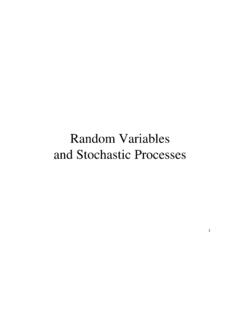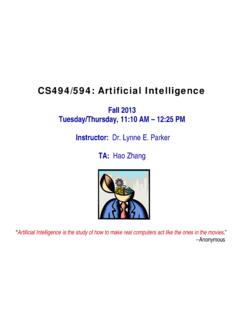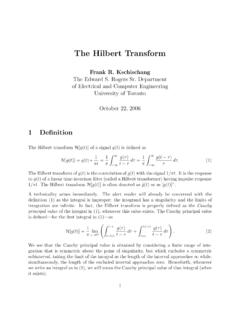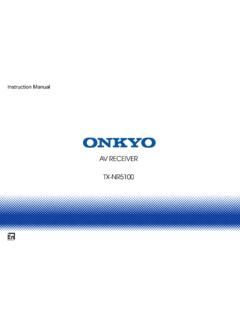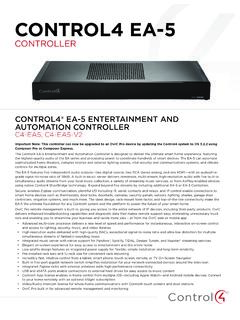Transcription of Wireshark Lab 3 – TCP - web.eecs.utk.edu
1 1 Wireshark Lab 3 TCP The following reference answers are based on the trace files provided with the text book, which can be downloaded from the textbook website. TCP Basics Answer the following questions for the TCP segments: 1. (1 point) What is the IP address and TCP port number used by your client computer (source) to transfer the file to What is the IP address and port number used by to receive the file. Solution: Client computer (source) IP address: TCP port number: 1161 Destination computer: IP address: TCP port number: 80 Figure 1: IP addresses and TCP port numbers of the client computer (source) and 22. (1 point) What is the sequence number of the TCP SYN segment that is used to initiate the TCP connection between the client computer and What is it in the segment that identifies the segment as a SYN segment?
2 Solution: Sequence number of the TCP SYN segment is used to initiate the TCP connection between the client computer and The value is 0 in this trace. The SYN flag is set to 1 and it indicates that this segment is a SYN segment. Figure 2: Sequence number of the TCP SYN segment 3. (2 points) What is the sequence number of the SYNACK segment sent by to the client computer in reply to the SYN? What is the value of the ACKnowledgement field in the SYNACK segment? How did determine that value? What is it in the segment that identifies the segment as a SYNACK segment? Solution: Sequence number of the SYNACK segment from to the client computer in reply to the SYN has the value of 0 in this trace. 3 The value of the ACKnowledgement field in the SYNACK segment is 1.
3 The value of the ACKnowledgement field in the SYNACK segment is determined by by adding 1 to the initial sequence number of SYN segment from the client computer ( the sequence number of the SYN segment initiated by the client computer is 0.). The SYN flag and Acknowledgement flag in the segment are set to 1 and they indicate that this segment is a SYNACK segment. Figure 3: Sequence number and Acknowledgement number of the SYNACK segment 4. (1 point) What is the sequence number of the TCP segment containing the HTTP POST command? Note that in order to find the POST command, you ll need to dig into the packet content field at the bottom of the Wireshark window, looking for a segment with a POST within its data field.
4 Solution: No. 4 segment is the TCP segment containing the HTTP POST command. The sequence number of this segment has the value of 1. 4 Figure 4: Sequence number of the TCP segment containing the HTTP POST command 5. (2 points) Consider the TCP segment containing the HTTP POST as the first segment in the TCP connection. What are the sequence numbers of the first six segments in the TCP connection (including the segment containing the HTTP POST)? At what time was each segment sent? When was the ACK for each segment received? Given the difference between when each TCP segment was sent, and when its acknowledgement was received, what is the RTT value for each of the six segments? What is the EstimatedRTT value (see page 237 in text) after the receipt of each ACK?
5 Assume that the value of the EstimatedRTT is equal to the measured RTT for the first segment, and then is computed using the EstimatedRTT equation on page 249 for all subsequent segments. Note: Wireshark has a nice feature that allows you to plot the RTT for each of the TCP segments sent. Select a TCP segment in the listing of captured packets window that is being sent from the client to the server . Then select: Statistics->TCP Stream Graph->Round Trip Time Graph. Solution: The HTTP POST segment is considered as the first segment. Segments 1 6 are No. 4, 5, 7, 8, 10, and 11 in this trace respectively. The ACKs of segments 1 6 are No. 6, 9, 12, 14, 15, and 16 in this trace. 5 Segment 1 sequence number: 1 Segment 2 sequence number: 566 Segment 3 sequence number: 2026 Segment 4 sequence number: 3486 Segment 5 sequence number: 4946 Segment 6 sequence number: 6406 The sending time and the received time of ACKs are tabulated in the following table.
6 Sent time ACK received time RTT (seconds) Segment 1 Segment 2 Segment 3 Segment 4 Segment 5 Segment 6
7 EstimatedRTT = * EstimatedRTT + * SampleRTT EstimatedRTT after the receipt of the ACK of segment 1: EstimatedRTT = RTT for Segment 1 = second EstimatedRTT after the receipt of the ACK of segment 2: EstimatedRTT = * + * = EstimatedRTT after the receipt of the ACK of segment 3: EstimatedRTT = * + * = EstimatedRTT after the receipt of the ACK of segment 4: EstimatedRTT = * + * = EstimatedRTT after the receipt of the ACK of segment 5: EstimatedRTT = * + * = EstimatedRTT after the receipt of the ACK of segment 6: EstimatedRTT = * + * = second 6 Figure 5: Segments 1 6 Figure 6: ACKs of segments 1 - 6 7 Figure 7: Round Trip Time Graph 86. (1 point) What is the length of each of the first six TCP segments?
8 Solution: Length of the first TCP segment (containing the HTTP POST): 565 bytes Length of each of the other five TCP segments: 1460 bytes (MSS) Figure 8: Lengths of segments 1 - 6 97. (1 point) What is the minimum amount of available buffer space advertised at the received for the entire trace? Does the lack of receiver buffer space ever throttle the sender? Solution: The minimum amount of buffer space ( receiver window) advertised at for the entire trace is 5840 bytes, which shows in the first acknowledgement from the server . This receiver window grows steadily until a maximum receiver buffer size of 62780 bytes. The sender is never throttled due to lacking of receiver buffer space by inspecting this trace. Figure 9: Minimum receive window advertised at (packet No.)
9 2) 108. (1 point) Are there any retransmitted segments in the trace file? What did you check for (in the trace) in order to answer this question? Solution: There are no retransmitted segments in the trace file. We can verify this by checking the sequence numbers of the TCP segments in the trace file. In the Time-Sequence-Graph (Stevens) of this trace, all sequence numbers from the source ( ) to the destination ( ) are increasing monotonically with respect to time. If there is a retransmitted segment, the sequence number of this retransmitted segment should be smaller than those of its neighboring segments. Figure 10: Sequence numbers of the segments from the source ( ) to the destination ( ) 119. (1 point) How much data does the receiver typically acknowledge in an ACK?
10 Can you identify cases where the receiver is ACKing every other received segment (see Table on page 257 in the text). Solution: The acknowledged sequence numbers of the ACKs are listed as follows. acknowledged sequence number acknowledged data ACK 1 566 566 ACK 2 2026 1460 ACK 3 3486 1460 ACK 4 4946 1460 ACK 5 6406 1460 ACK 6 7866 1460 ACK 7 9013 1147 ACK 8 10473 1460 ACK 9 11933 1460 ACK 10 13393 1460 ACK 11 14853 1460 ACK 12 16313 1460 .. The difference between the acknowledged sequence numbers of two consecutive ACKs indicates the data received by the server between these two ACKs. By inspecting the amount of acknowledged data by each ACK, there are cases where the receiver is ACKing every other segment. For example, segment of No.
